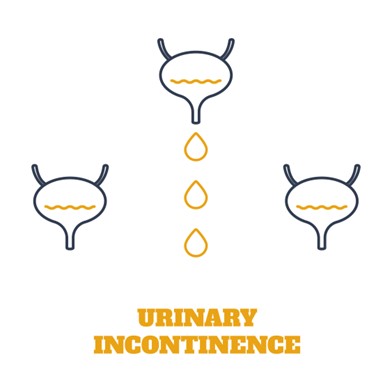Urinary incontinence (UI) is more common than you might think. It’s a condition that affects many people all over the world. Around the globe, millions of individuals experience some form of urinary incontinence. Understanding UI helps recognize its significant impact and the widespread demographic it affects.
Introduction to Urinary Incontinence
Urinary incontinence means not being able to control urine leakage. It’s a manageable yet often frustrating issue. Many people experience it at some point in their lives. Handling it can boost your confidence and enhance daily activities. For instance, it’s hard to enjoy an outing if you’re worried about leaks.
Approximately 200 million people worldwide are affected by urinary incontinence. This statistic highlights how widespread the condition is. It also shows how crucial it is to talk about it. Raising awareness encourages people to seek solutions and experience the freedom a potential treatment can offer.
Types of Urinary Incontinence
There are several types of urinary incontinence. Each type might affect people differently, but understanding helps in managing them better.
- Stress Incontinence: Occurs when physical activities like coughing or laughing lead to leaks.
- Urge Incontinence: Comes with a sudden, strong need to urinate immediately.
- Overflow Incontinence: Means frequent dribbling because the bladder doesn’t empty completely.
- Functional Incontinence: Happening when a physical or mental impairment prevents someone from making it to the restroom in time.
- Mixed Incontinence: A combination of symptoms from the above types.
Recognizing these types early helps many plan and find urinary incontinence treatments that work best for them.
Recognizing the Symptoms
The symptoms of urinary incontinence are unmistakable but often embarrassing. It’s common for individuals to experience urine leakages during daily activities. Imagine laughing with friends and suddenly feeling wet. That’s one of the most recognizable signs.
People might also find themselves running to the bathroom frequently. Noticing frequent and sudden urges to urinate is another symptom. Such urges can disrupt daily routines. Some also experience urine leakage without warning, which can be distressing.
The emotional effects, like feeling embarrassed or anxious, are significant. It’s essential to identify these symptoms early on. Seeking help and understanding what you’re experiencing can offer relief.
Pinpointing Causes of Urinary Incontinence
Urinary incontinence causes vary significantly. Some causes are temporary, while others are more persistent.
Temporary Causes
- Urinary tract infections can make it challenging to control your bladder.
- Medications or simply drinking too much caffeine offer short-term impacts.
Long-Term Causes
- Pregnancy and childbirth can trigger lasting issues.
- Aging or menopause may cause lasting changes.
- Medical conditions, like diabetes and obesity, contribute significantly to the likelihood of developing UI.
It’s important to distinguish between myths and facts concerning these causes. Urinary incontinence doesn’t only affect older adults or women—it’s broader than that. Understanding the real causes supports finding suitable solutions.
Diagnosis and Assessing Underlying Factors
Getting a diagnosis starts by chatting with your doctor. They would likely ask about your medical history and require a physical exam.
They may check multiple factors, such as your dietary habits or medications. Some doctors might even recommend a urine test to ensure there are no infections.
It’s crucial to know what to expect during these assessments. Routine evaluations help in pinpointing effective urinary incontinence treatments. Don’t hesitate to ask questions during these discussions. Knowing what happens during medical evaluations ensures there are no surprises for you.
Medical and Alternative Treatments for Urinary Incontinence
There are several urinary incontinence treatments available, making it easier to manage.
- Bladder Training: Helps keep a regular schedule while urinating, making it easier to control urges.
- Lifestyle Changes: These can involve diet adjustments like reducing caffeine and alcohol intake.
- Physical Therapy: Pelvic exercises strengthen the muscles involved in controlling the bladder.
- Medication: Certain drugs might help manage symptoms and add an extra layer of control.
- Urinary Incontinence Surgery: For some cases, surgery could be beneficial. It involves procedures to improve bladder support or function.
- Alternative Treatments: Options like acupuncture and herbal supplements might also provide relief for some individuals.
Exploring these urinary incontinence treatments opens doors to regaining control and comfort.
Coping Mechanisms and Support Systems
Coping with urinary incontinence isn’t just about medical treatments. Emotional support and practical tools play huge roles too.
- Protective Products: Many items, such as absorbent pads or liners, can help manage leaking discreetly.
- Seeking Support: Talking to family, counselors, or support groups can provide emotional relief. Open dialogue encourages understanding and eradicates misconceptions.
- Specialist Help: Medical professionals specializing in pelvic health offer a variety of treatment methods and evaluations.
These resources foster a nurturing environment for anyone dealing with urinary incontinence.
Conclusion
Urinary incontinence is a widespread, manageable condition affecting millions globally. Though it might seem daunting, current treatments offer hope and relief. Don’t let embarrassment prevent you from seeking help. Consulting a healthcare provider opens avenues for better management and improved well-being.
Be proactive about exploring different urinary incontinence treatments and options available to you. Encouraging a positive, proactive approach can significantly enhance the quality of your daily life. Embrace understanding and regain the confidence to engage in life unrestricted! Remember, you’re not alone in this. Reach out and find solutions that make living with urinary incontinence easier.



